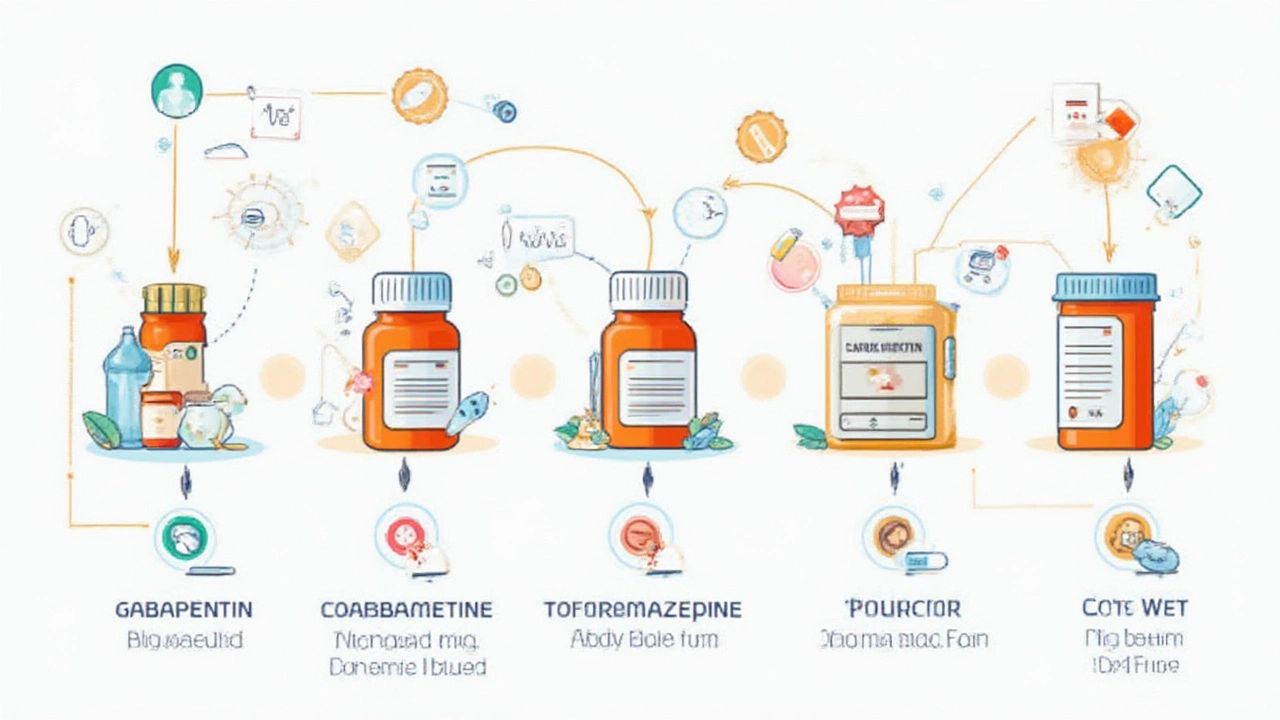The world of nerve pain meds is confusing, right? One prescription feels like a gamble, and finding the best option is tricky. Gabapentin gets a lot of attention for treating neuropathic pain—think nerve injuries, post-herpetic neuralgia, and diabetic neuropathy. But what happens when it just doesn’t work, or side effects hit too hard? Dozens of alternatives crowd the shelves, each with their own quirks. Some are old-school anti-seizure meds, others double up as mood boosters or migraine busters. It’s messy and fascinating.
The Main Players: What Are Popular Gabapentin Alternatives?
Let’s get straight to the curious collection of medicines similar to Gabapentin. Here’s where things get real: most alternatives didn’t even start out as painkillers. Take carbamazepine. This one’s been around since the 1960s as an anti-seizure drug but now pops up in nerve pain clinics. There’s topiramate, more famous for migraines and epilepsy, but showing up for pain syndromes by 2025. Duloxetine and amitriptyline? Officially antidepressants, but often a first-line option for burning, tingling nerves. Pregabalin—sometimes called Gabapentin’s fancier cousin—offers nearly identical benefits, but watch out: its street value has actually exploded in the UK recently because of misuse worries.
What’s wild is that some non-drug options are racing to catch up. But still, these prescription medicines dominate. Here’s a table with a bird’s-eye view to help keep things clear:
| Medicine | Main Use | Typical Dose (per day) | Common Pros | Common Cons |
|---|---|---|---|---|
| Carbamazepine | Seizures, nerve pain | 200-1200mg | Well-studied, cheap | Drowsiness, rash, blood problems |
| Duloxetine | Depression, neuropathic pain | 60-120mg | Treats mood and pain, energising | Nausea, sweating, sexual side effects |
| Topiramate | Migraine, seizures, pain | 50-400mg | Helps with migraines, weight loss | Cognitive fog, taste changes, kidney stones |
| Amitriptyline | Depression, nerve pain | 10-75mg | Cheap, helps sleep | Dry mouth, drowsiness, weight gain |
| Pregabalin | Nerve pain, anxiety, seizures | 75-600mg | Fast-acting, effective for anxiety too | Dizziness, dependency risk |
Take a look at these options and you’ll spot a pattern: most have extra off-label uses. Some are lifesavers if you have both pain and sleep issues, or pain and depression. The latest treatments, like SNRIs (serotonin-norepinephrine reuptake inhibitors), keep changing the scene. No wonder clinicians end up tailoring treatment person by person.
Carbamazepine: Old Reliable with Some Surprises
This med’s been saving people with trigeminal neuralgia (that stabbing face pain) long before Gabapentin showed up. Carbamazepine is tough—it goes after those odd, electric zaps in nerves when others fail. The reason? It blocks sodium channels (the “gates” that control nerve firing), helping calm things down in damaged nerves. It’s also dirt cheap, and GPs love the familiarity.
Sounds perfect, right? Not so fast. Here’s what trips people up. Carbamazepine isn’t just tough on pain, it can be tough on the body. Drowsiness, blurry vision, wobbly walking, upset stomach—most people deal with a few hiccups when they start. The big risks go further, though: about 1 in 10,000 people may get a severe skin reaction, sometimes even life-threatening. It can mess with your blood cells, so blood tests are a must at the start. Women taking birth control should be careful, as it can make pills less effective. Oh, and grapefruit juice? Big no-no. It cranks up side effects.
Carbamazepine has something else: drug interactions. It can lower levels of many meds (including itself!) or make others stick around longer. Some people swear by it, but it’s rarely a first go unless nothing else works. You need regular blood checks and a watchful GP. The bottom line? It’s great for certain nerve pains, but trickier for everyday aches. Stick to a low starting dose and increase slowly to dodge the side effects as much as possible.

Duloxetine, Amitriptyline, and the Antidepressant Connection
If you’ve ever wondered why the pharmacist hands you an antidepressant for pain, you’re not alone. The secret is in the brain chemicals—serotonin and noradrenaline help nerves transmit signals, and boosting them can settle down frazzled nerves. medicines similar to Gabapentin such as duloxetine and amitriptyline don’t just tackle mood problems; they work wonders on chronic nerve pain from diabetes or after shingles.
Duloxetine is especially popular these days. Doctors like that it works for both pain and low mood—a two-for-one deal. People struggling with fibromyalgia or nerve pain after injury often report decent relief. Unlike heavy sedatives, it’s usually energizing, which helps if fatigue is part of your health battle. The main headaches? Nausea (sometimes rough for the first week), increased sweating, and the occasional trouble in the bedroom (think libido crash or delayed orgasm). Most side effects fade after a fortnight, but occasionally they linger and force a switch.
Amitriptyline is the old classic and one of the cheapest nerves pain meds in the world. South Bristol doctors love it for people who can’t sleep because pain keeps them up. Oddly, it works better at very low doses (10-50mg, way less than for depression), but it’s still sedating, so don’t take it before a big evening out. Dry mouth, weight gain, and sluggish mornings are the main gripes. For people over 65, docs tend to dodge it due to fall risk and confusion. Still, for nerve pain with insomnia? It’s a no-brainer.
It’s worth knowing: neither duloxetine nor amitriptyline are quick fixes. It often takes two weeks for real benefits. Coming off fast can bring withdrawal symptoms, so always taper as your GP recommends. And don’t forget—neither goes well with certain other antidepressants (risk of serotonin syndrome), so check your full list of meds first, always.
Topiramate, Pregabalin, and Unsung Newcomers
Topiramate has a bit of a cult following—mostly among migraine sufferers who discover they also have aches that don’t go away. Initially meant as an anti-seizure pill, its painkilling reputation is rising. Why? It targets multiple brain chemicals, calming both nerve and brain overactivity. People like that it helps with migraines and sometimes weight. The catch: cognitive fog and word-finding problems can sneak up, with friends and family usually the first to spot it. Tingling in fingers, taste changes (Coke can taste like metal), and the rare kidney stone round out the risks. For nerve pain alone, most doctors consider it a third-line option. Small doses, taken at night, reduce next-day fuzziness.
Pregabalin feels like the iPhone upgrade to Gabapentin. It hits the same receptors better, which explains why patients either love it or find themselves dizzy or spacey. It starts working quickly (sometimes in 2-3 days), so it’s great for sudden flare-ups. For some, especially those dealing with anxiety as well, it’s a real game changer. But the things that make it popular also stir controversy: high street value, growing dependency rates, and a dizzy, almost drunk-like feeling if you take too much. UK prescribing rules tightened in 2019 for this exact reason, and doctors watch use closely. If you’ve ever mixed up your morning dose, you know it knocks you sideways. Always stick to the routine, and keep your GP in the loop about other meds to avoid dangerous combos.
One unusual new arrival: venlafaxine. Mostly famous for depression, it’s sliding into nerve pain guidelines for stubborn or mixed-pain types, especially where anxiety’s in the mix. Doctors start low, then ramp up slowly to dodge high blood pressure. Still, among this whole class, it’s duloxetine that gets most attention lately, mostly due to NHS and private pain clinic guidelines in 2025 that nudge it ahead of older tricyclics.
Fancy reading an epic compare-and-contrast with some lesser-known and newer pain relief stars? You’ll find a full list of medicines similar to Gabapentin with expert opinions and up-to-the-day facts right here—and it’s honestly worth a glance if you’re struggling to find your next best move.

How Do You Choose? Tips and Common Scenarios
This is where things get personal. You can scroll through guides and charts, but real life rarely fits a table. Imagine you’re a 34-year-old with shooting pain after shingles—your GP’s likely to shortlist amitriptyline or gabapentin, then move to duloxetine if side effects are bad. But what if you’re caring for an elderly parent who already takes ten other meds? Carbamazepine’s wild interactions rule it out. If you drive for a living, anything that fogs your brain—pregabalin, high-strength amitriptyline—will be out. If sleep’s your enemy, a sedating option at night can be gold.
Here are practical things to ask yourself or your doctor:
- Do you need help mainly with pain, mood, or sleep—or all three?
- Can you tolerate feeling foggy, or does your job demand a sharp mind?
- Are you on other medications with interaction risks?
- Do you have liver or kidney problems?
- Are you planning a pregnancy (or currently pregnant)?
- How comfortable are you with regular blood tests?
Some people try three or four options before landing on “the one.” The trick is don’t give up too early—most take time to really settle in. Write down your side effects, how you sleep, your mood—bring this journal to every review. And if you ever feel more miserable than relieved, speak up: switching is common, and sometimes a different class altogether is the answer. Never double up medicines in the same class without explicit advice, by the way—combos like Gabapentin plus pregabalin can trigger weird side effects. Lastly, keep routines consistent, especially if you’re working shifts or juggling family life; skipping or doubling up doses risks more chaos.
GPs in Bristol, and the rest of the UK, tend to start low and go slow. NHS pain services will try to offer talking therapies or physio alongside meds—because pills alone rarely fix persistent pain. That doesn’t mean you shouldn’t keep searching for that “just right” balance, though. Loads of people do find it, often after a few experiments.






Aishwarya Sivaraj
i been on pregabalin for 2 years now and honestly it saved my life but the dizziness at first was brutal like i thought i was gonna fall over every time i stood up
took me 3 weeks to adjust but now i sleep better and the burning in my feet is gone
also i lost 12kg which no one told me about lol
sharicka holloway
I tried duloxetine for my diabetic neuropathy and the nausea almost made me quit. But after the first week, it was like a switch flipped. No more lying awake at 3 a.m. screaming from pain. Worth the ugly start.
Iives Perl
they're all just mind control drugs. the FDA knows gabapentin makes people docile. watch the commercials. they never show the side effects. they just say 'feel better' lol 🤡
Gaurav Sharma
The clinical trial data for amitriptyline in neuropathic pain is statistically insignificant when adjusted for publication bias. Also, the sedative effect is a confounding variable in most studies. This is not medicine. It is pharmacological placebo.
Emma louise
So let me get this straight - you’re telling me we’re giving people antidepressants for pain because Big Pharma ran out of real drugs? Classic. America’s answer to everything is a pill. Just say no.
Rebecca Price
I’m a nurse in rural Texas and I’ve seen people on carbamazepine for 15 years. One woman had trigeminal neuralgia so bad she couldn’t brush her teeth. Carbamazepine gave her back her life. But yeah, the blood work? Non-negotiable. And grapefruit? Don’t even joke about it. I’ve had patients end up in ER because they thought ‘it’s just juice’.
Savakrit Singh
The structural similarity between pregabalin and GABA analogs suggests a high potential for receptor downregulation. Furthermore, the UK’s 2019 reclassification was a direct response to escalating misuse rates, which correlates with social isolation metrics in post-pandemic populations. 📉💊
Sam HardcastleJIV
One must question the epistemological validity of prescribing psychoactive agents for somatic conditions. The mind-body dichotomy, as articulated by Descartes, remains unaddressed in contemporary pharmacological paradigms. One wonders whether we are treating pain - or merely masking existential despair with chemical sedation.
archana das
my grandma took amitriptyline for her nerve pain and she said it made her feel like she was wrapped in a warm blanket at night. she slept like a baby. no fancy science needed. just kindness and a little pill. 🌙
Alex Hess
This article reads like a pharmaceutical sales pitch disguised as medical advice. Who even wrote this? A rep from Pfizer? The table is biased, the tone is manipulative, and the ‘expert’ link is clearly a spam domain. If you’re reading this, stop trusting blogs and talk to a real neurologist - not some content farm with a .su domain.